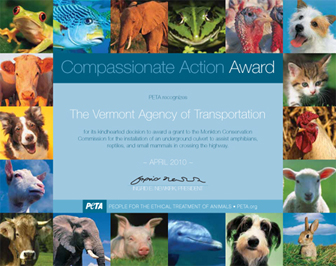How Vermont’s Animals Cross the Road
It’s spring! The sun is shining, the birds are singing, and the dueling robins I saw on my way to work this morning are a sign that it’s mating season. With animals across the country looking for love, a $150,000 grant awarded by the Vermont Agency of Transportation’s Transportation Enhancements Grant Committee (TEGC) couldn’t have come at a better time. The Monkton Conservation Commission in Vermont plans to use the grant to install a “salamander crossing” under Monkton’s Vergennes Road, which the state’s leading reptile and amphibian expert describes as “one of the most important of the known amphibian crossings in the state.” This passage will offer amphibians, reptiles, and small mammals a safe way to travel between uplands southeast of the road and an important swamp northwest of the crossing—by helping them avoid the dangers that claim the lives of millions of animals who become roadkill every year in the U.S. For recognizing that all animals deserve consideration and protection, PETA is giving the Vermont Agency of Transportation a Compassionate Action Award.
With “ecopassages” (both under and above roads) popping up all over the country—including Massachusetts’ salamander tunnels and California’s cougar corridors—animals everywhere are having an easier time traveling, getting food, and mating. Have you spotted any ecopassages in your community?
Written by Logan Scherer

